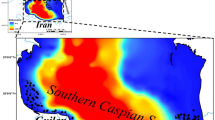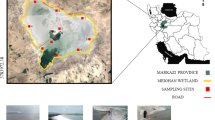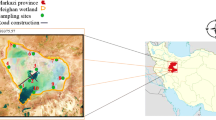Abstract
The Anzali wetland (located in northern Iran) and many parts of its catchment are considered important habitats for the swan mussel (Anodonta cygnea). The habitat of this native bioindicator mussel is being threatened in many locations of the catchment due to various anthropogenic activities. The present study aimed to apply a classification tree model (J48 algorithm) to predict the habitat preferences of A. cygnea in 12 sampling sites based on various water quality and physical-habitat variables. The species was present in 50% of sampling sites, while it was absent in the remaining of the sampling sites. In total, 144 samples of A. cygnea (72 presence and 72 absence instances) were monthly measured together with the abiotic variables during 1-year study period (2017–2018). For the CT model, two-thirds of datasets (96 instances) served as a training and the remainder was employed for the validation set (48 instances). Among 25 environmental variables introduced to the model (with pruning confidence factor = 0.10, threefold cross-validation and 5 times randomization effort), the validity of 6 variables was confirmed by the model in all three subsets. Water salinity, flow velocity, water depth and water turbidity were jointly predicted by the model in three subsets. The model predicted that the absence of A. cygnea might be associated with increasing flow velocity, total phosphate and water turbidity. In contrast, the presence of A. cygnea might be related to decreased water depth and increased calcium concentration. The model also confirmed that all predicted variables for the species might be completely dependent on the water salinity. According to the chi-square test (x2 = 26.53, p < 0.05), the habitat condition of A. cygnea is influenced by significant variations in the spatio-temporal patterns.






Similar content being viewed by others
References
Ambelu, A., Lock, K., & Goethals, P. (2010). Comparison of modelling techniques to predict macroinvertebrate community composition in rivers of Ethiopia. Ecological Informatics, 5, 147–152.
APHA, AWWA, WEF. (2012). Standard methods for examination of water and waste water. 22nd edition. American Public Health Association, Washington DC.
Byrne, A., Moorkens, E. A., Anderson, R., Killeen, I. J. & Regan, E. C. (2009). Ireland red list no. 2-non-marine Molluscs. National Parks and Wildlife Service. Department of the Environment, Heritage and Local Government, Dublin.
Cohen, J. (1960). A coefficient of agreement for nominal scale. Educational and Psychological Measurement, 20, 37–46.
De'ath, G., & Fabricius, K. E. (2000). Classification and regression trees: a powerful yet simple technique for ecological data analysis. Ecology, 81, 3178–3192.
Everaert, G., Bennetsen, E., & Goethals, P. (2016). An applicability index for reliable and applicable decision trees in water quality modelling. Ecological Informatics, 32, 1–6.
Fielding, A. H., & Bell, J. F. (1997). A review of methods for the assessment of prediction errors in conservation presence/absence models. Environmental Conservation, 24, 38–49.
Haghi Vayghan, A., Zarkami, R., Sadeghi, R., & Fazli, H. (2015). Modelling habitat preferences of Caspian kutum, Rutilus frisii kutum (Kamensky, 1901) (Actinopterygii, Cypriniformes) in the Caspian Sea. Hydrobiologia, 766, 103–119.
Hamedani, H., Naqinezhad, A., & Fadaie, F. (2017). Ramsar international wetlands of Alagol, Almagol and Ajigol in eastern parts of the Caspian Sea: a floristic and habitat survey. Caspian Journal of Environmental Science, 15, 357–372.
Harkantra, S. N., & Parulekar, A. H. (1994). Soft sediment dwelling macro invertebrates of Rajapur bay, central west of India. Indian Journal of Marine Sciences, 23, 31–34.
Kantor, Y. I., Schileyko, A. A., Vinarski, M. V. & Sysoev, A. V. (2009). Catalogue of the continental mollusks of Russia and adjacent territories. 330 pp.
Killeen, I., Aldridge, D. & Oliver, G. (2004). Freshwater bivalves of Britain and Ireland. FSC.
Kohavi, R. (1995). A study of cross-validation and bootstrap for accuracy estimation and model selection. In: Lavrac, M., Wrobel, S. (Eds.), Proceedings of the International Joint Conference on Artificial Intelligence, pp, 1137–1143.
Lecomte, J. B., Benoit, H. P., Etienne, M. P., & Parent, B. L. (2013). Modelling the habitat associations and spatial distribution of benthic macroinvertebrates: a hierarchical Bayesian model for zero-inflated biomass data. Ecological Modelling, 265, 74–84.
Lock, K., & Goethals, P. (2012). Habitat suitability modelling for mayflies (Ephemeroptera) in Flanders (Belgium). Ecological Informatics, 17, 30–35.
Lopes-Lima, M., Lima, P., Hinzmann, M., Rocha, A., & Machado, J. (2014). Selective feeding by Anodonta cygnea (Linnaeus, 1771): the effects of seasonal changes and nutritional demands. Limnologica-Ecology and Management of Inland Waters, 44, 18–22.
Macia, A., Abrantes, K. G. S., & Paula, J. (2003). Thorn fish Terapon jarbua (Forskal) predation on juvenile white shrimp Penaeus indicus (H. Milne Edwards) and brown shrimp Metapenaeus monoceros (Fabricius): the effect of turbidity, prey density, substrate type and pneumatophore density. Journal of Experimental Marine Biology and Ecology, 291, 29–56.
Michaelidis, B., & Athanasiadou, P. (1994). Effect of reduced oxygen tension on the heart rate and the kinetic properties of glycolytic key enzymes PFK, PK and glycogen phosphorylase from the freshwater mussel Anodonta cygnea (L.). Comparative Biochemistry and Physiology Part B: Comparative Biochemistry, 108, 165–172.
Nezami Balochi, S., Khara, H., Jamalzadeh Fallah, F., & Akbarzadeh, A. (2006). Survey factors of water physical and chemical in Anzali wetland, it’s inlet and outlet rivers. Pajouhesh & Sazandegi, 73, 76–83.
Pourang, N., Richardson, C. A., & Mortazavi, M. S. (2010). Heavy metal concentrations in the soft tissues of swan mussel (Anodonta cygnea) and surficial sediments from Anzali wetland, Iran. Environmental Monitoring and Assessment, 163, 195–213.
Quinlan, J. R. (1986). Induction of decision trees. Machine Learning, 1, 81–106.
Rosińska, B., Chojnacki, J. C., Lewandowska, A., Matwiejczuk, A., & Samiczak, A. (2008). Biometrics of swan mussels (Anodonta cygnea) from chosen lakes in the Pomeranian Region. Limnological Review, 8, 79–84.
Sadeghi, R., Zarkami, R., Sabetraftar, K., & Van Damme, P. (2012a). Use of support vector machines (SVMs) to predict distribution of an invasive water fern Azolla filiculoides (Lam.) in Anzali wetland, southern Caspian Sea, Iran. Ecological Modelling, 244, 117–126.
Sadeghi, R., Zarkami, R., Sabetraftar, K., & Van Damme, P. (2012b). Application of classification trees to model the distribution pattern of a new exotic species Azolla filiculoides (Lam.) in Selkeh Wildlife Refuge, Anzali wetland, Iran. Ecological Modelling, 243, 8–17.
Sadeghi, R., Zarkami, R., Sabetraftar, K., & Van Damme, P. (2013). Application of genetic algorithm and greedy stepwise to select input variables in classification tree models for the prediction of habitat requirements of Azolla filiculoides (Lam.) in Anzali wetland, Iran. Ecological Modelling, 251, 44–53.
Sadeghi, R., Zarkami, R., & Van Damme, P. (2014). Modelling habitat preference of an alien aquatic fern, Azolla filiculoides (Lam.), in Anzali wetland (Iran) using data-driven methods. Ecological Modelling, 284, 1–9.
Sadeghi, R., Zarkami, R., & Van Damme, P. (2017). Analysing the occurrence of an invasive aquatic fern in wetland using data-driven and multivariate techniques. Wetlands Ecology and Management, 25, 485–500.
Senius, K. E. O., & Lagerspetz, K. Y. H. (1978). Effects of calcium and magnesium on the thermal resistance of ciliary activity in the freshwater mussel Anodonta. Journal of Thermal Biology, 3, 153–157.
Soleimanirad, A., Kamrani, E., Poorbagher, H., Bahremand, M., & Keshavarz, M. (2016). Effects of environmental factors on community structure of macrobenthic bivalves in the marine protected area of Jask (Gulf of Oman) using the redundancy analysis (RDA). Journal of Fisheries, 69, 63–75.
Witten, I. H., Frank, E. & Mark, A. (2011). “Data Mining: practical machine learning tools and techniques.” 3rd. (Morgan Kaufmann: San Francisco) 629.
Zając, K. (2002). Habitat preferences of swan mussel Anodonta cygnea (Linnaeus 1758) (Bivalvia, Unionidae) in relation to structure and successional stage of floodplain waterbodies. Ekológia (Bratislava), 21, 345–355.
Zając, K. (2005). Anodonta cygnea. In Z. Głowaciński & J. Nowacki (Eds.), Polish red data book of animals: invertebrates (pp. 349–351). Krakow.
Zarkami, R. 2016. Invasive aquatic plants. Haghshanas publishing. 184 p. (in Farsi).
Zarkami, R. & Kia, S. (2019). Study of habitat suitability of Anodonta cygnea (Linnaeus, 1758) as a biological indicator, in different parts of Anzali wetland. Journal of Animal Research (Iranian Journal of Biology), (In Farsi: In Press).
Zarkami, R., Goethals, P., & De Pauw, N. (2010). Use of classification tree methods to study the habitat requirements of tench (Tinca tinca) (L., 1758). Caspian Journal of Environmental Science, 8, 55–63.
Zarkami, R., Sadeghi, R., & Goethals, P. (2012). Use of fish distribution modelling for river management. Ecological Modelling, 230, 44–49.
Zarkami, R., Moradi, M., Sadeghi, R., Bani, A., & Bani, A. (2018). Input variable selection with greedy stepwise search algorithm for analysing the probability of fish occurrence: a case study for Alburnoides mossulensis in the Gamasiab River, Iran. Ecological Engineering, 118, 104–110.
Zarkami, R., Darizin, Z., Sadeghi, R., Bani, A., & Ghane, A. (2019). Use of data-driven model to analyse the occurrence patterns of an indicator fish species in river: a case study for Alburnoides eichwaldii (De Filippi, 1863) in Shafaroud River, north of Iran. Ecological Engineering, 133, 10–19.
Zettler, M. L., Jueg, U., Menzel-Harloff, H., Gollnitz, U., Petrick, S., Weber, E. & Seemann, R. (2006). Die Land-und Suswassermollusken Mecklenburg-Vorpommerns. Obotritendruck Schwerin.
Zieritz, A., Azam-Ali, S., Marriott, L. A., Nasir, A. B. M. N., Ng, Q. N., Razak, N. A. A. B. A., & Watts, M. (2018). Biochemical composition of freshwater mussels in Malaysia: a neglected nutrient source for rural communities. Journal of Food Composition and Analysis, 72, 104–114.
Acknowledgements
The authors would like to thank Guilan Environment Protection Bureau for providing the opportunity to field sampling. The authors would like to acknowledge Pourya Bahri for providing the map of the sampling sites. He is following his Master of Science study in the Department of Environmental Science, Faculty of Natural Resources, University of Guilan, Iran.
Author information
Authors and Affiliations
Corresponding author
Additional information
Publisher’s note
Springer Nature remains neutral with regard to jurisdictional claims in published maps and institutional affiliations.
Rights and permissions
About this article
Cite this article
Zarkami, R., Kia, S. & Pasvisheh, R.S. Modelling the habitat preferences of the swan mussel (Anodonta cygnea) using data-driven model. Environ Monit Assess 192, 685 (2020). https://doi.org/10.1007/s10661-020-08651-1
Received:
Accepted:
Published:
DOI: https://doi.org/10.1007/s10661-020-08651-1




